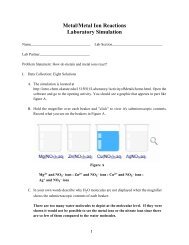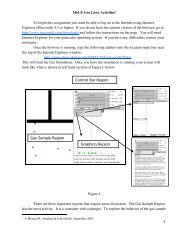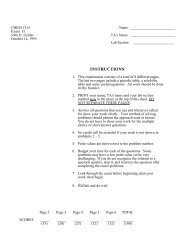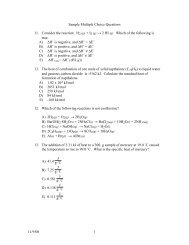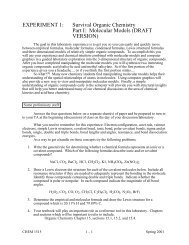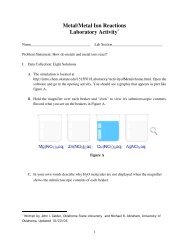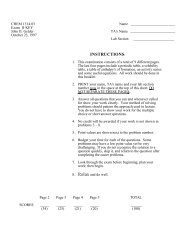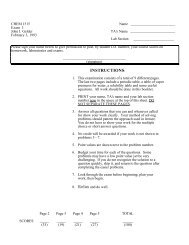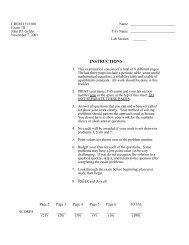Exam II CHEM 1515 SP98.
Exam II CHEM 1515 SP98.
Exam II CHEM 1515 SP98.
- No tags were found...
You also want an ePaper? Increase the reach of your titles
YUMPU automatically turns print PDFs into web optimized ePapers that Google loves.
<strong>CHEM</strong> <strong>1515</strong>.002<br />
Name ________________________<br />
<strong>Exam</strong> <strong>II</strong><br />
John <strong>II</strong>. Gelder TA's Name ________________________<br />
March 4, 1998<br />
Lab Section _______<br />
INSTRUCTIONS:<br />
1. This examination consists of a total of 8 different pages.<br />
The last three pages include a periodic table, a table of<br />
vapor pressures for water, a solubility table, a table of<br />
ionic structures and packing and an activity series. All<br />
work should be done in this booklet.<br />
2. PRINT your name, TA's name and your lab section<br />
number now in the space at the top of this sheet. DO<br />
NOT SEPARATE THESE PAGES .<br />
3. Answer all questions that you can and whenever called<br />
for show your work clearly. Your method of solving<br />
problems should pattern the approach used in lecture.<br />
You do not have to show your work for the multiple<br />
choice or short answer questions.<br />
4. No credit will be awarded if your work is not shown in<br />
problems 3, 4, 5, 6 and 7.<br />
5. Point values are shown next to the problem number.<br />
6. Budget your time for each of the questions. Some<br />
problems may have a low point value yet be very<br />
challenging. If you do not recognize the solution to a<br />
question quickly, skip it, and return to the question after<br />
completing the easier problems.<br />
7. Look through the exam before beginning; plan your<br />
work; then begin.<br />
8. Relax and do well.<br />
Page 2 Page 3 Page 4 Page 5 TOTAL<br />
SCORES _____ _____ _____ _____ ______<br />
(24) (26) (34) (16) (100)
<strong>CHEM</strong> <strong>1515</strong> EXAM <strong>II</strong> PAGE 2<br />
(12) 1. Write the chemical formula(s) of the product(s) and balance the following reactions. Identify all<br />
products phases as either (g)as, (l)iquid, (s)olid or (aq)ueous. Soluble ionic compounds should be<br />
written in the form of their component ions.<br />
a) Na 2 S 2 O 8 (aq) + I – (aq) →<br />
b) iron(<strong>II</strong>I) chloride(aq) + sodium hydroxide(aq) →<br />
c) ammonium nirate(aq) + sodium sulfate(aq) →<br />
d) Mg(s) + Au 3+ (aq) →<br />
(6) 2. Write the ionic and net ionic chemical equations for 1a) and 1b).<br />
1a)<br />
Ionic equation:<br />
Net Ionic equation:<br />
1b)<br />
Ionic equation:<br />
Net Ionic equation:<br />
(6) 3. Describe how you would prepare 250.00 mLs of an aqueous solution of NaOH which is 0.200 M.<br />
(Include any safety information which would be important to the person preparing the solution.)
<strong>CHEM</strong> <strong>1515</strong> EXAM <strong>II</strong> PAGE 3<br />
(26) 4. A solution is prepared containing 8.00 g of trichloroacetic acid, CCl 3 COOH, in 92.0 g of water. This<br />
solution is also 0.509 M.<br />
(6) a) calculate the mol fraction of trichloroacetic acid in the solution.<br />
(6) b) calculate the freezing point of the solution (assuming the CCl 3 COOH does not dissociate into ions.)<br />
(4) c) the experimental freezing point of this solution is found to be –1.69 ˚C. Is trichloroacetic acid a strong,<br />
weak or nonelectrolyte in water Explain.<br />
(6) d) Identify the chemical specie(s) in an aqueous solution of trichloroacetic acid. (NOTE: you need not<br />
include water, just the specie(s) associated with trichloroacetic acid.) Which is/are present in the highest<br />
concentration Explain.<br />
(4) e) Calculate the density of this solution.
<strong>CHEM</strong> <strong>1515</strong> EXAM <strong>II</strong> PAGE 4<br />
(34) 5. The 2nd order rate constant for the gas phase decomposition<br />
2NOCl(g) → 2NO(g) + Cl 2 (g)<br />
of nitrosyl chloride, NOCl, is 1.18 x 10 –2 M –1·s –1 at 450 K.<br />
(8) a) If the initial concentration of NOCl is 0.500 M calculate the concentration of NOCl after 56.5 seconds.<br />
(4) b) What is the fraction of the original NOCl is remaining<br />
(6) c) How long will it take for the concentration of NOCl to fall to one-half its initial value (as given in a)<br />
(8) d) If the activation energy, E a , for the decomposition reaction is 102 kJ·mol –1 , calculate the rate constant<br />
for the reaction at 600 K.<br />
(4) e) Suggest a reaction mechanism for the decomposition reaction.<br />
(4) f) Draw the activated complex for the slow step in your reaction mechanism (be sure to label where bond<br />
breaking and forming are occuring).
<strong>CHEM</strong> <strong>1515</strong> EXAM <strong>II</strong> PAGE 5<br />
(8) 6. Camphor, C 10 H 16 O, is frequently used to determine the molar mass of organic compounds using<br />
freezing point depression data because of its large freezing point constant, 37.7 m·˚C –1 . An unknown<br />
organic compound of mass 0.840 g lowered the freezing point of 25.0 g of camphor by 7.6 ˚C. What is<br />
the molar mass of the organic compound<br />
(8) 7. The reaction<br />
PCl 5 (g) ä PCl 3 (g) + Cl 2 (g)<br />
was studied at 760 ˚C. 0.200 mol of PC 5 are placed in a 1.00 liter container and allowed to decompose.<br />
After equilibrium was established the concentration of PCl 3 was found to be 0.195 M. Calculate the<br />
equilibrium constant for the reaction at this temperature.
<strong>CHEM</strong> <strong>1515</strong> EXAM <strong>II</strong> PAGE 6<br />
1<br />
2<br />
3<br />
4<br />
5<br />
6<br />
7<br />
IA<br />
1<br />
H<br />
1.008<br />
3<br />
Li<br />
6.94<br />
11<br />
<strong>II</strong>A<br />
4<br />
Be<br />
9.01<br />
12<br />
Na Mg<br />
22.99 24.30 <strong>II</strong>IB<br />
19 20 21<br />
K<br />
Ca<br />
Sc<br />
IVB<br />
22<br />
Ti<br />
VB<br />
23<br />
VIB V<strong>II</strong>B<br />
24 25<br />
26<br />
V<strong>II</strong>I<br />
27<br />
39.10 40.08 44.96 47.88 50.94 52.00 54.94 55.85 58.93 58.69 63.55 65.38 69.72 72.59 74.92 78.96 79.90 83.80<br />
37<br />
Rb Sr<br />
38 39<br />
Y Zr<br />
40 41 42 43 44 45 46 47 48 49 50 51 52 53 54<br />
Nb Mo Tc Ru Rh Pd Ag Cd In Sn Sb Te I Xe<br />
85.47 87.62 88.91 91.22 92.91 95.94 (98) 101.1 102.9 106.4 107.9 112.4 114.8 118.7 121.8 127.6 126.9 131.3<br />
55 56 57 72 73 74 76 77 78 79 81 82 83 84 85 86<br />
Cs<br />
Ba<br />
La<br />
Periodic Table of the Elements<br />
Hf<br />
28<br />
IB<br />
29<br />
V Cr Mn Fe Co Ni Cu<br />
<strong>II</strong>B<br />
30<br />
<strong>II</strong>IA IVA VA VIA V<strong>II</strong>A 4.00<br />
5 6 7 8<br />
B C N O F<br />
9 10<br />
Ne<br />
10.81 12.01 14.01 16.00 19.00 20.18<br />
13 14 15 16 17 18<br />
Al<br />
26.98<br />
31<br />
Si<br />
P<br />
28.09 30.97<br />
32 33<br />
32.06<br />
34<br />
35.45 39.95<br />
35 36<br />
Zn Ga Ge As Se Br Kr<br />
S<br />
Cl<br />
V<strong>II</strong>IA<br />
2<br />
Ta W Re 75<br />
Os Ir Pt Au Hg 80<br />
Tl Pb Bi Po At Rn<br />
132.9 137.3 138.9 178.5 180.9 183.8 186.2 190.2 192.2 195.1 197.0 200.6 204.4 207.2 209.0 (209) (210)<br />
87 88 89 104 105 106 107 108 109<br />
Fr<br />
(223)<br />
Ra<br />
226.0<br />
Ac<br />
227.0<br />
Rf Db Sg<br />
Bh<br />
Hs Mt<br />
(261) (262) (263) (262) (265) (266)<br />
He<br />
Ar<br />
(222)<br />
Lanthanides<br />
Actinides<br />
58 59 60 61 62 63 64<br />
Ce Pr Nd Pm Sm Eu Gd 65 66 67 68 69 70 71<br />
Tb Dy Ho Er Tm Yb Lu<br />
140.1 140.9 144.2 (145) 150.4 152.0 157.2 158.9 162.5 164.9 167.3 168.9 173.0 175.0<br />
90 91 92 93 94 95 96<br />
Th Pa U Np Pu Am Cm 97 98 99 100 101 102 103<br />
Bk Cf Es Fm Md No Lr<br />
232.0 231.0 238.0 237.0 (244) (243) (247) (247) (251) (252) (257) (258) (259) (260)<br />
Useful Information<br />
PV = nRT<br />
R = 0.0821 L·atm<br />
mol·K = 8.314 J<br />
mol·K<br />
P solution = χ solvent P˚solvent<br />
g<br />
density of H 2 O = 1.00<br />
cm 3<br />
∆T = ikm k f (H 2 O) = 1.86 ˚C m k b(H 2 O) = 0.512 ˚C m<br />
ln<br />
⎛k 1 ⎞<br />
⎝ k 2 ⎠<br />
= E a<br />
R ⎝ ⎛ 1<br />
T ⎠ ⎞<br />
2<br />
- 1 T 1<br />
ln<br />
⎛[A] t⎞<br />
1 1<br />
⎝ [A] o ⎠<br />
= -kt<br />
[A] t<br />
- [A] o<br />
= kt<br />
K p = K c (RT) ∆n<br />
x 1,2 = –b±<br />
b2 – 4ac<br />
2a for ax 2 + bx + c = 0
<strong>CHEM</strong> <strong>1515</strong> EXAM <strong>II</strong> PAGE 7<br />
Temperature (°C)<br />
-5<br />
05<br />
10<br />
15<br />
20<br />
25<br />
30<br />
35<br />
40<br />
45<br />
Vapor<br />
Pressure(mmHg)<br />
3.2<br />
4.6<br />
6.52<br />
9.20<br />
12.8<br />
17.5<br />
23.8<br />
31.8<br />
42.1<br />
55.3<br />
71.9<br />
Temperature (°C)<br />
50<br />
55<br />
60<br />
65<br />
70<br />
75<br />
80<br />
85<br />
90<br />
95<br />
100<br />
Vapor<br />
Pressure(mmHg)<br />
92.5<br />
118.0<br />
149.4<br />
187.5<br />
233.7<br />
289.1<br />
355.1<br />
433.6<br />
525.8<br />
633.9<br />
760<br />
Solubility Table<br />
Ion Solubility Exceptions<br />
NO – 3 soluble none<br />
ClO – 4 soluble none<br />
Cl – soluble except Ag + , Hg 2+ 2 , *Pb 2+<br />
I – soluble except Ag + , Hg 2+ 2 , Pb 2+<br />
SO 2– 4 soluble except Ca 2+ , Ba 2+ , Sr 2+ , Hg 2+ , Pb 2+ , Ag +<br />
CO 3<br />
2– insoluble except Group IA and NH 4<br />
+<br />
PO 3– 4 insoluble<br />
+<br />
except Group IA and NH 4<br />
- OH insoluble except Group IA, *Ca 2+ , Ba 2+ , Sr 2+<br />
S 2– insoluble except Group IA, <strong>II</strong>A and NH + 4<br />
Na + soluble none<br />
NH + 4 soluble none<br />
K + soluble none<br />
*slightly soluble
<strong>CHEM</strong> <strong>1515</strong> EXAM <strong>II</strong> PAGE 8<br />
Metal<br />
Half-Reaction<br />
Reaction<br />
Lithium Li → Li + + e –<br />
Potassium K → K + + e –<br />
Barium Ba → Ba 2+ + 2e –<br />
Calcium Ca → Ca 2+ + 2e –<br />
Sodium Na → Na + + e –<br />
Magnesium Mg → Mg 2+ + 2e –<br />
Aluminum Al → Al 3+ + 3e –<br />
Manganese Mn → Mn 2+ + 2e –<br />
Zinc Zn → Zn 2+ + 2e –<br />
Chromium Cr → Cr 3+ + 3e –<br />
Iron Fe → Fe 2+ + 2e –<br />
Cobalt Co → Co 2+ + 2e –<br />
Nickel Ni → Ni 2+ + 2e –<br />
Tin Sn → Sn 2+ + 2e –<br />
Lead Pb → Pb 2+ + 2e –<br />
Hydrogen H 2 → 2H + + 2e –<br />
Copper Cu → Cu 2+ + 2e –<br />
Silver Ag → Ag + + e –<br />
Mercury Hg → Hg 2+ + 2e –<br />
Platinum Pt → Pt 2+ + 2e –<br />
Gold Au → Au 3+ + 3e –




